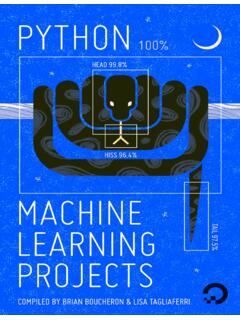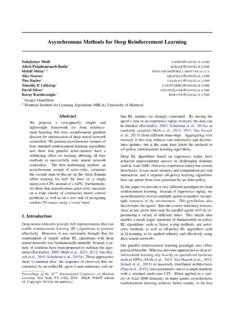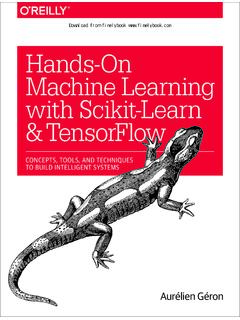Transcription of Abstract - arXiv
1 Offline reinforcement learning as One BigSequence Modeling ProblemMichael JannerQiyang LiSergey LevineUniversity of California at Berkeley{janner, learning (RL) is typically concerned with estimating stationarypolicies or single-step models, leveraging the Markov property to factorize prob-lems in time. However, we can also view RL as a generic sequence modelingproblem, with the goal being to produce a sequence of actions that leads to asequence of high rewards. Viewed in this way, it is tempting to consider whetherhigh-capacity sequence prediction models that work well in other domains, suchas natural-language processing, can also provide effective solutions to the RLproblem.}
2 To this end, we explore how RL can be tackled with the tools of sequencemodeling, using a Transformer architecture to model distributions over trajectoriesand repurposing beam search as a planning algorithm. Framing RL as sequencemodeling problem simplifies a range of design decisions, allowing us to dispensewith many of the components common in offline RL algorithms. We demonstratethe flexibility of this approach across long-horizon dynamics prediction, imitationlearning, goal-conditioned RL, and offline RL. Further, we show that this approachcan be combined with existing model-free algorithms to yield a state-of-the-artplanner in sparse-reward, long-horizon IntroductionThe standard treatment of reinforcement learning relies on decomposing a long-horizon problem intosmaller, more local subproblems.
3 In model-free algorithms, this takes the form of the principle ofoptimality (Bellman, 1957), a recursion that leads naturally to the class of dynamic programmingmethods likeQ- learning . In model-based algorithms, this decomposition takes the form of single-steppredictive models, which reduce the problem of predicting high-dimensional, policy-dependent statetrajectories to that of estimating a comparatively simpler, policy-agnostic transition , we can also view reinforcement learning as analogous to a sequence generation problem,with the goal being to produce a sequence of actions that, when enacted in an environment, willyield a sequence of high rewards.
4 In this paper, we consider the logical extreme of this analogy:does the toolbox of contemporary sequence modeling itself provide a viable reinforcement learningalgorithm? We investigate this question by treating trajectories as unstructured sequences of states,actions, and rewards. We model the distribution of these trajectories using a Transformer architecture(Vaswani et al., 2017), the current tool of choice for capturing long-horizon dependencies. In placeof the trajectory optimizers common in model-based control, we use beam search (Reddy, 1977), aheuristic decoding scheme ubiquitous in natural language processing, as a planning reinforcement learning , and more broadly data-driven control, as a sequence modeling problemhandles many of the considerations that typically require distinct solutions: actor-critic algorithmsrequire separate actors and critics, model-based algorithms require predictive dynamics models, andoffline RL methods often require estimation of the behavior policy (Fujimoto et al.)
5 , 2019). TheseCode is available Conference on Neural Information Processing Systems (NeurIPS 2021), Sydney, [ ] 29 Nov 2021 Trajectory TransformerFigure 1 (Architecture)The Trajectory Transformer trains on sequences of (autoregressively dis-cretized) states, actions, and rewards. Planning with the Trajectory Transformer mirrors the samplingprocedure used to generate sequences from a language estimate different densities or distributions, such as that over actions in the case of actorsand behavior policies, or that over states in the case of dynamics models.
6 Even value functions can beviewed as performing inference in a graphical model with auxiliary optimality variables, amountingto estimation of the distribution over future rewards (Levine, 2018). All of these problems can beunified under a single sequence model, which treats states, actions, and rewards as simply a stream ofdata. The advantage of this perspective is that high-capacity sequence model architectures can bebrought to bear on the problem, resulting in a more streamlined approach that could benefit from thesame scalability underlying large-scale unsupervised learning results (Brown et al.)
7 , 2020).We refer to our model as a Trajectory Transformer (Figure 1) and evaluate it in the offline regimeso as to be able to make use of large amounts of prior interaction data. The Trajectory Transformeris a substantially more reliable long-horizon predictor than conventional dynamics models, even inMarkovian environments for which the standard model parameterization is in principle decoded with a modified beam search procedure that biases trajectory samples according totheir cumulative reward, the Trajectory Transformer attains results on offline RL benchmarks thatare competitive with the best prior methods designed specifically for that setting.
8 Additionally, wedescribe how variations of the same decoding procedure yield a model-based imitation learningmethod, a goal-reaching method, and, when combined with dynamic programming, a state-of-the-artplanner for sparse-reward, long-horizon tasks. Our results suggest that the algorithms and architecturalmotifs that have been widely applicable in unsupervised learning carry similar benefits in Related WorkRecent advances in sequence modeling with deep networks have led to rapid improvement inthe effectiveness of such models, from LSTMs and sequence-to-sequence models (Hochreiter &Schmidhuber, 1997; Sutskever et al.)
9 , 2014) to Transformer architectures with self-attention (Vaswaniet al., 2017). In light of this, it is tempting to consider how such sequence models can lead toimproved performance in RL, which is also concerned with sequential processes (Sutton, 1988).Indeed, a number of prior works have studied applying sequence models of various types to representcomponents in standard RL algorithms, such as policies, value functions, and models (Bakker, 2002;Heess et al., 2015a; Chiappa et al., 2017; Parisotto et al., 2020; Parisotto & Salakhutdinov, 2021;Kumar et al., 2020b).
10 While such works demonstrate the importance of such models for representingmemory (Oh et al., 2016), they still rely on standard RL algorithmic advances to improve goal in our work is different: we aim to replace as much of the RL pipeline as possible withsequence modeling, so as to produce a simpler method whose effectiveness is determined by therepresentational capacity of the sequence model rather than algorithmic of probability distributions and densities arises in many places in learning -based is most obvious in model-based RL, where it is used to train predictive models that canthen be used for planning or policy learning (Sutton, 1990; Silver et al.)



![arXiv:0706.3639v1 [cs.AI] 25 Jun 2007](/cache/preview/4/1/3/9/3/1/4/b/thumb-4139314b93ef86b7b4c2d05ebcc88e46.jpg)
![arXiv:1301.3781v3 [cs.CL] 7 Sep 2013](/cache/preview/4/d/5/0/4/3/4/0/thumb-4d504340120163c0bdf3f4678d8d217f.jpg)
![@google.com arXiv:1609.03499v2 [cs.SD] 19 Sep 2016](/cache/preview/c/3/4/9/4/6/9/b/thumb-c349469b499107d21e221f2ac908f8b2.jpg)










